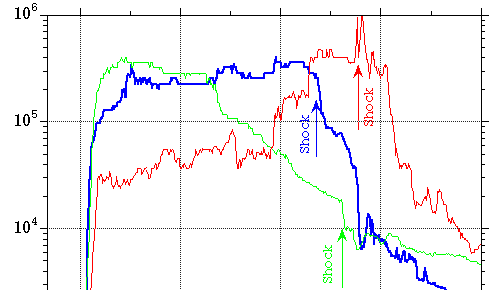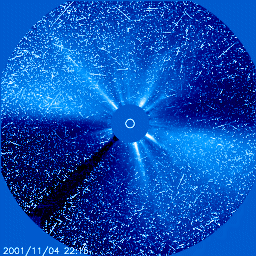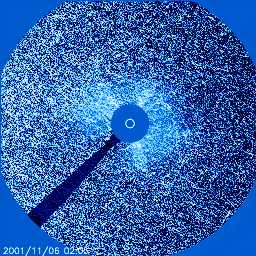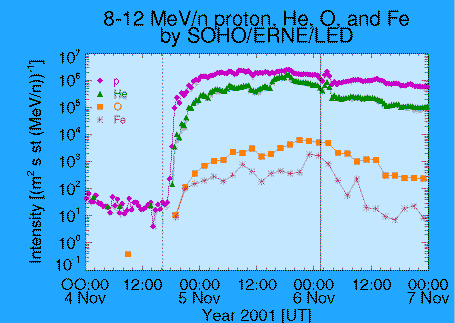Shocking Events
Click on images for uncropped/larger images. | |
Caption: It's not over 'till the shock has passed! That's what SOHO's science and operations teams have learned to take into account when faced with "blizzards" of high-energy particles blurring their images, threatening the health and safety of some instruments. In fact, the most intense particle flux observed with SOHO - by half an order of magnitude - occured more than 30 hours after the X-ray flare and CME on 4 November 2001.
The figure at the top of the page, from the CELIAS/MTOF instrument, compares the three most intense energetic particle showers observed by SOHO - the Bastille Day event of 14 July 2000, an event from 8 November 2000, and the 4 November 2001 event. The flux of high-energy particles in each event is shown as a function of time since the corresponding X-ray event.
The 4 November event was also seen by the Energetic and Relativistic Nuclei and Electron (ERNE) instrument, as shown in the plot below (click on image for a larger plot - PostScript & PDF versions available). The ERNE instrument distinguishes different types of energetic particles, separating e.g. protons from helium nuclei.
The two LASCO C3 images shown above are snapshots of the "snowstorm" at about 6 hours (usually near the most intense period) and 34 hours past the trigger of the 4 November event. Clearly, conditions got worse!
The identification of the shock time can be done to sub-minute precision in this plot from the CELIAS/MTOF instrument, showing the count rate of their main detector. According to the available data, it seems like the spike in the high-energy particle counts preceded the shock by about 7 minutes.
Early in the morning on the day after Thanksgiving 2001, another particle event started, and particle levels got just above the safing limit for the Coronal Diagnostic Spectrometer. As the particle counts first went down, then headed upwards again in the GOES plot that was monitored in real-time, the CDS operators decided to go ahead and safe the instrument in case a severe peak was on its way with the shock. As it turned out, particle levels during the shock passage were much below "record" levels, and subsided quickly.
The halo CME that caused this shock is featured in the Pick of the Week called Double "halo" Coronal Mass Ejections
Instruments: |
CELIAS (Charge, Element, and Isotope Analysis System) |
Picture credits: |
SOHO/CELIAS, SOHO/ERNE, and SOHO/LASCO (ESA & NASA) |






